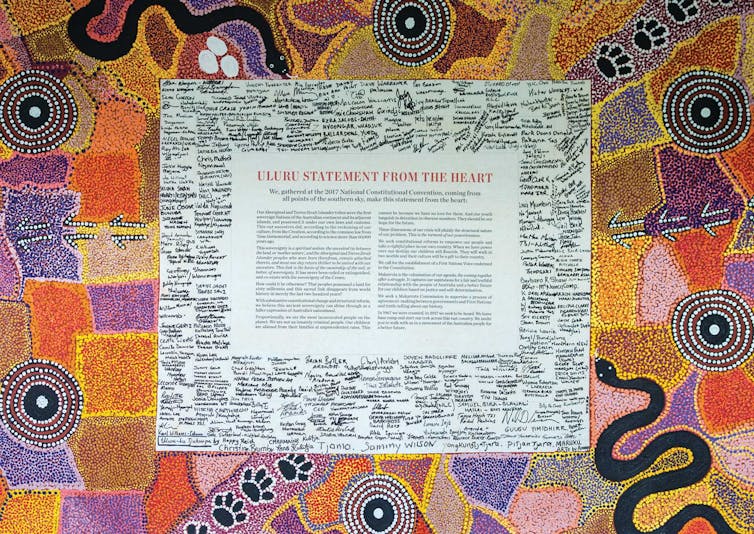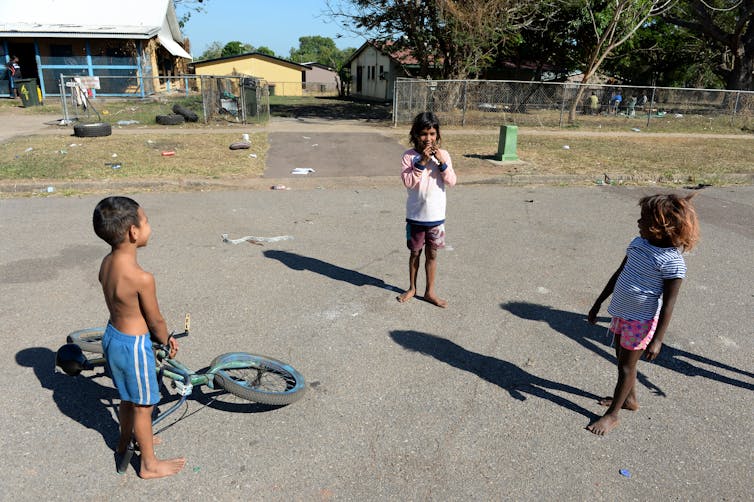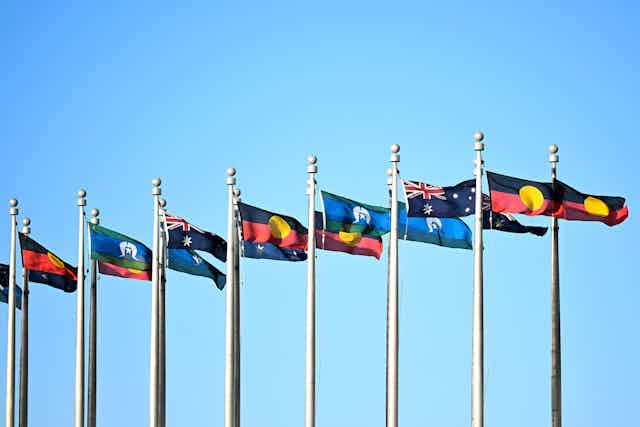As we start to see the campaign for the Voice referendum gather momentum, there are a lot of Australian voters with genuine questions, trying to understand the proposal and wade through the information – including misinformation and active (that is, intentional) disinformation – that is out there in this public debate.
This type of information can manipulate people’s understanding of the issues, distort their vote and the result. It can also cause enormous harm to Aboriginal and Torres Strait Islander people.
Those looking for answers that avoid misinformation and disinformation often – with good reason – turn to experts. And there are lots stepping up and trying to help, including those writing for The Conversation, and most recently @ReferendumQandA, a group of public, human rights and international lawyers answering common questions as the referendum approaches. When you read this information, you should always be wary of people speaking outside of their expertise and experience, and anonymous accounts where these points can’t be checked.
With that in mind, we are a group of three non-Indigenous and Indigenous academics, providing our answers to ten key questions arising in the Voice debate, where the answers are often confused and distorted by misinformation.
1. Do Aboriginal and Torres Strait Islander people support the Voice?
While there is not a single view among Aboriginal and Torres Strait Islander people, there is significant – indeed extraordinary – levels of support among them for the Voice.
First, Indigenous support is demonstrated by the deliberative processes that sits behind the Uluru Statement from the Heart. This involved more than 1,200 Aboriginal and Torres Strait Islander people from across the country (the claim that non-Indigenous people attended the dialogues is false).
From this process, delegates were able to arrive at a national consensus position, prioritising the reforms of Voice, towards Makarrata (Treaty and Truth).
Second, polling confirms the Voice continues to receive overwhelming Indigenous support. Two polls from 2023 confirm that 80% and 83% of Indigenous people support the Voice.
Further, Indigenous organisations across the country have indicated their support for the Voice. This includes land-based representative bodies such as the Northern Territory Land Councils and the Kimberley Land Council, and peak service organisations such as the Australian Indigenous Doctors Association.

2. Will the Voice insert race into the Constitution?
The concept of race is already in section 51(xxvi) of the Constitution, which gives the Commonwealth parliament the power to legislate for “people of any race for whom it is deemed to be necessary to make special laws”.
That section was originally included so as to give effect to the White Australia Policy, and Aboriginal people were excluded from it. But since the section was amended in 1967, following a nationwide campaign for change, it has included the power to make such laws “for people […] of the aboriginal race in any State”.
As was intended in 1967, the power has been exercised for the benefit of Aboriginal and Torres Strait Islander people (such as in relation to native title and cultural heritage protection laws). On the other hand, the same power could also arguably be used to pass laws that operate to their detriment. Its existence and breadth underscores the need for a mechanism – the Voice – to listen to the very people to whom those laws would apply.
3. How will the Voice make a practical difference?
The Voice will give Aboriginal and Torres Strait Islander people a constitutionally guaranteed right to speak to government and the parliament about what’s needed for practical improvements to people’s lives. This in turn would help address disadvantage and systemic discrimination.
Aboriginal and Torres Strait Islander people have answers to many pressing issues confronting their communities, but all too often are not heard. The positive impact of listening to Indigenous voices is supported by research such as that conducted in Australia led by Fiona Stanley and Marcia Langton, and internationally at the Harvard Project on American Indian Development.
4. How can the Voice represent the diversity of Aboriginal and Torres Strait Islander views?
Claims that the Voice will be a “Canberra Voice”, unrepresentative of the diversity of Aboriginal and Torres Strait Islander people, and their views, misrepresents the proposal.
The constitutional provision requires only that the Voice is an “Aboriginal and Torres Strait Islander Voice”, and leaves the rules governing its composition to be determined by parliament. It is appropriate that parliament is responsible for determining the composition of the Voice, because the identity, experience, culture and views of First Nations across Australia are complex and diverse. This means it will need to be done in close consultation with local Indigenous communities, and will require ongoing monitoring, input and evaluation in cooperation with those communities. The parliament is best placed to undertake that sort of ongoing negotiation.
The government has committed to exactly that form of consultation in the design principles that have been set in collaboration with the Referendum Working Group, a group of Indigenous leaders. These principles indicate how the government intends the Voice to represent the diversity of Aboriginal and Torres Strait Islander people, and their views. These principles commit the government to a Voice that is chosen based on the wishes of local communities, is not appointed by government, reflects gender balance and youth perspectives, and all members must be Indigenous.
These principles are informed by the recommendations of the 2021 Indigenous Voice Co-Design process as well as the design and proposed reforms of ATSIC.
Importantly, however, the government recognises the need for further consultation with Indigenous people on the specific design of the Voice.
These commitments will ensure the Voice is representative of the diversity of Aboriginal and Torres Strait Islander views.
5. Is the Voice in breach of international human rights standards?
No. In fact, the Voice is supported under international human rights law as it recognises Indigenous peoples’ rights to political representation and is consistent with the UN Declaration on the Rights of Indigenous Peoples.
In human rights and international law, equality and anti-discrimination means more than just treating people exactly the same. Indeed, this type of formal equality will often result in ongoing discrimination against people who have been historically marginalised because it doesn’t redress institutional and structural discrimination, or recognise difference.
The Voice has been endorsed by several UN treaty bodies, which have also expressed serious concern about the human rights violations Indigenous people in Australia continue to experience.

6. Don’t Aboriginal and Torres Strait Islander people already have lots of ‘voices’ to government and parliament?
No. There is currently no representative body to provide, in a nationally coordinated way, the government and parliament with the views and experience of the Aboriginal and Torres Strait Islander people who will be affected by their decisions.
To the extent there are other Indigenous organisations working with government and parliament, the Voice will complement, not detract, from their work. For instance, peak service organisations working in areas such as health, education and law, offer important Indigenous specific services and advice to government in service delivery, they are not representative.
And while there may be more Aboriginal parliamentarians than ever – and this should be celebrated – these individuals do not primarily represent Aboriginal and Torres Strait Islander people. They are party members bound by party policy, or individual MPs, who represent the whole of their constituencies. Further, Indigenous representation in the parliament is not guaranteed – it will rise and fall depending on party selection, and election results.
Finally, while individual traditional owners might be able to negotiate land claims and native title rights with government, they do not have a nationally representative voice to speak to parliament and government in a coordinated way about the laws and policies that will apply to these negotiations. There is no one to make sure the rules of the game are fair.
7. Will the Voice give rise to High Court litigation and clog up parliamentary work?
No. According to the prevailing weight of informed legal opinion, the establishment of the Voice does not pose any abnormal risk of excessive litigation.
Any suggestion the Voice would clog up the parliament or the government ignores the parliament’s ability to determine its own business, and the parliament’s legislative power to determine how the Voice will engage with the government.
Read more: What happens if the government goes against the advice of the Voice to Parliament?
8. How does the Voice affect sovereignty?
Sovereignty is a complex idea, referring at a general level to ultimate political authority within a community. However, people talk about it in different ways. The Voice proposal interacts with sovereignty at three different levels.
First, the call for the Voice reform is based on the strong assertion in the Uluru Statement from the Heart of the continuing and unceded sovereignty of Aboriginal and Torres Strait Islander peoples.
Second, there is nothing in the Voice proposal which alters the British Crown’s assertion of sovereignty at settlement, nor the fact that First Nations people have never consented to the forceful transfer of sovereignty to the Australian nation as we now know it.
Read more: What we mean when we say 'sovereignty was never ceded'
The third is under international law, which requires the agreement or consent of Aboriginal and Torres Strait Islander people to cede sovereignty. This is not what is happening under the Voice proposal. Indeed, international treaty bodies have repeatedly confirmed that the Voice would be a positive step for the recognition and political participation rights of Aboriginal and Torres Strait Islander people within the state.
9. Why do we need to put the Voice in the Constitution?
There are two key parts to this answer. The first is that the Voice has a number of objectives, one of which is the constitutional recognition of Aboriginal and Torres Strait Islander people as the First Peoples of the land. First Nations people, through the Uluru Statement from the Heart, indicated they wished for recognition in the form of the Voice. If we are serious about recognition, we should do it in a way that accords with the wishes of those to be recognised.
The second part of the answer relates to the operation of the Voice. If the Voice is in the Constitution, it can only be abolished by another referendum, rather than by a change of government policy. This gives it independence and stability, so it can fulfil its function of speaking about matters that might not be politically popular.
10. Do Australians have enough detail to vote at the referendum?
Yes. There’s often a lot of confusion about this question, which is because there are two types of detail that people talk about.
The first is the detail about the constitutional change. This is the bit Australians are being asked to vote on, and the bit that is “permanent” (subject to a future referendum). There is heaps of detail in relation to the constitutional change, including the wording of the amendment, the referendum question, the explanatory memorandum to the amendment, a parliamentary inquiry’s report, and the government has even taken the extraordinary route of releasing the solicitor-general’s advice on the legal soundness of the amendment.
The second is the detail about what the legislation establishing the “nuts and bolts” of the Voice will look like. To be clear, this detail is not part of the constitutional amendment – and it is entirely normal for constitutions to leave this type of detail to be worked out in future by the parliament. It would be misleading to release the full detail of the Voice, because this detail would need to be passed through parliament, and would be subject to future change.
However, there is some detail about what the Voice will look like. The government has taken the sensible option of indicating what it will do following a successful referendum, and how it will go about setting up the Voice. It has worked with the Referendum Working Group to finalise a set of design principles that provide the outline of what the voice will look like – how it will represent Aboriginal and Torres Strait Islander people across the country, what functions it will have, and how it will be accountable.

